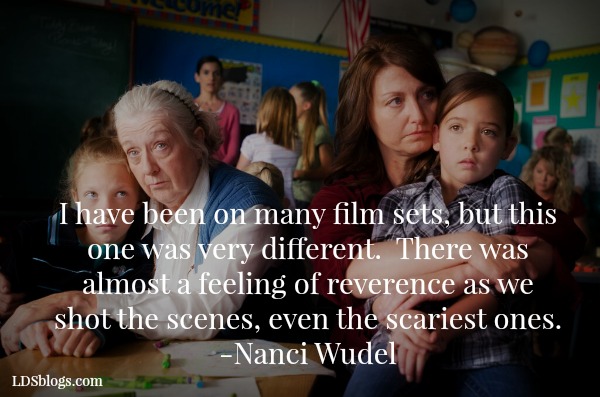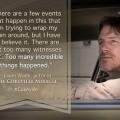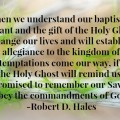I recently got to discuss The Cokeville Miracle with Nancy Wudel, who plays one of the elementary teachers in the movie. She gave me a lot of insight into things behind the scenes.
LDS Blogs: This movie is based on a true event. Do you remember that day? If so, what were your thoughts at that time (in 1986)?
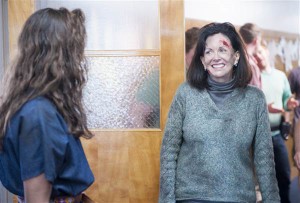 Nanci: That’s a day I won’t forget. My dearest and best friend, Shari Wixom Morrow, had a 12-year-old nephew, Kam Wixom, who was a sixth-grader in the Cokeville classroom that day. Kam’s cousins – Shari’s daughters – were also best friends with my daughters, so we witnessed first-hand the terror and agony they felt for their cousin, Kam. As the news spread to Kam’s extended family in Utah, and to us, in Arizona, one thought dominated all of the rest — these teachers and children were going to die.
Nanci: That’s a day I won’t forget. My dearest and best friend, Shari Wixom Morrow, had a 12-year-old nephew, Kam Wixom, who was a sixth-grader in the Cokeville classroom that day. Kam’s cousins – Shari’s daughters – were also best friends with my daughters, so we witnessed first-hand the terror and agony they felt for their cousin, Kam. As the news spread to Kam’s extended family in Utah, and to us, in Arizona, one thought dominated all of the rest — these teachers and children were going to die.
The school was surrounded with police, FBI, SWAT teams, sheriff’s department personnel, and others, but with the madman wearing a deadman’s switch around his wrist, no one could do anything to stop him. This was going to have a very, very bad ending.
The only thing anyone could do was to pray and trust that God would be in control. And what a test of faith it was!
LDS Blogs: Are you a parent? When the final film came out, did you struggle to watch it?
Nanci: Yes, I have four children and 16 grandchildren, so yes, the film did hit some raw nerves with me. It was intense to watch, but it wasn’t a struggle. That’s the power of a film based on a true story — you know the ending. And you realize that in order to appreciate the incredibly uplifting ending, you have to feel the terror that precedes it. You have to see and feel the horror of the situation in order to understand that out of something so devastating came something so good, and inspiring, and life-changing.
LDS Blogs: How was it filming with such a scary character in the room? Were the children actually frightened?
Nanci: The children who were professional actors weren’t frightened, although they had to act as if they were. And, some of the children who were background actors, or extras, were a little caught off guard that first day when the “bad guy” started yelling. But that was quickly dispelled with all the stops and starts for different camera angles and retakes. So, what you saw in the final film was just some really, really good acting from the children.
LDS Blogs: How has this film effected you? Has it strengthened your belief in God?
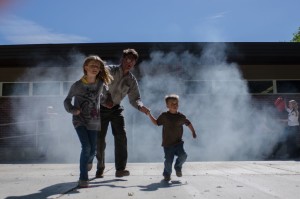 Nanci: I have been on many film sets, but this one was very different. There was almost a feeling of reverence as we shot the scenes, even the scariest ones. We all sensed it – adults and children. We were portraying events that were not only true, but that had changed so many lives, past and even present, for the better. The irony of something so awful resulting in something so tremendously positive was felt day after day on the set.
Nanci: I have been on many film sets, but this one was very different. There was almost a feeling of reverence as we shot the scenes, even the scariest ones. We all sensed it – adults and children. We were portraying events that were not only true, but that had changed so many lives, past and even present, for the better. The irony of something so awful resulting in something so tremendously positive was felt day after day on the set.
We felt honored to be part of a film that taught so many life-lessons, in such a real-to-life way. How can anyone who sees this movie, and learns of what really happened that day in Cokeville, ever doubt the existence of a Higher Power?
As actors, vicariously living this horrific, yet magnificent event, we felt humbled and appreciative that we “got it” — the message that God indeed exists … and that prayer works. The detailed facts about the bombing that surfaced in the 1986 investigation are mind-boggling as they testify of those principles.
This film has made me so very grateful for the knowledge I have that God lives, that He knows us, and that He loves us. He wants to help us – but we have to ask. We have to pray; we must pray … because we can’t do this life on our own.
LDS Blogs: I loved hearing about those who proved to be heroes that day. Were you able to chat with any of the teachers or students who were there? What struck you talking to them?
Nanci: Yes, T.C. graciously made the set “open” to the people of Cokeville and the survivors. When we weren’t needed on set, we had the tremendous opportunity to talk to many of the teachers and students who had been there. We were amazed at how, 29 years later, they were still humbled and awed by what happened that day. It was obvious that reliving the madness, as well as the miracles, gave them a closure they had not had before.
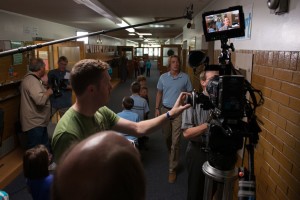 To watch and relive the horror of that day, but in context with the incredible good that came out of it, was very healing to them. Knowing that their “complete” story would finally be told was very important to them. They wanted the world to know what really happened that day. Terror was turned into testimony. God’s existence and intervention was witnessed first-hand. Seeing this story being filmed in such a thoughtful and sensitive manner was something they recognized and appreciated.
To watch and relive the horror of that day, but in context with the incredible good that came out of it, was very healing to them. Knowing that their “complete” story would finally be told was very important to them. They wanted the world to know what really happened that day. Terror was turned into testimony. God’s existence and intervention was witnessed first-hand. Seeing this story being filmed in such a thoughtful and sensitive manner was something they recognized and appreciated.
LDS Blogs: Is there anything you’d like to add that I may not have asked?
Nanci: The genius who made the magic happen in this film is T.C. Christensen. In my opinion, his brilliance and talents were well showcased. He took a complicated story and made it flow with clarity and power. Anyone who has ever worked with T.C. knows that he’s a legend in the independent film world. He certainly didn’t let anyone down with “The Cokeville Miracle,” which I think is his best film so far.
The emotion T.C. evoked was based on raw truth, both good and bad. He told it “like it was.” His commitment to stay true to the facts of the story made a finished film that brings so many raw emotions to the surface for the theater audience. Many people are going back multiple times to see it again and again.
This is a film that appeals to any culture, religion, race, or belief. Its universal appeal makes it strong and solid entertainment, as well as inspirational.
My favorite part of the film is the credits where T.C. showcases the actual survivors. What a profound lesson is taught by those most–telling family photos — again another testament of the existence of God. I think that in our normal “day and age,” many survivors of this kind of trauma would likely be fairly dysfunctional. In the typical worldly scenario, it wouldn’t be surprising to see such victims turn to alcohol, drugs, etc., in order to cope (and who could really blame them?).
But here we see on the screen, not confused and damaged souls, but functioning, happy families! And why? Because of their acknowledgement of God’s intervention … and of angelic ministrations. The survivors were not afraid, then or now, to bear witness of what they saw. They were witnesses to miracles, and it changed their lives forever.
LDS Blogs: Thank you Nanci. This has been very enlightening.
About Patty Sampson
Patty thrives on all things creative. You’ll often find her in the garden pretending she is a suburban farmer. She loves meeting new people, and is devoted to her friends and family. In her heart she is a Midwesterner even though life has moved her all over the country. She believes in “blooming where you’re planted” and has found purpose in every place she has been. She has a deep and abiding love for the Savior and the Gospel of Jesus Christ. And she loves editing LDS Blogs because it is a constant spiritual uplift. Not many people can say their job builds their witness of the Savior.
Twitter •

